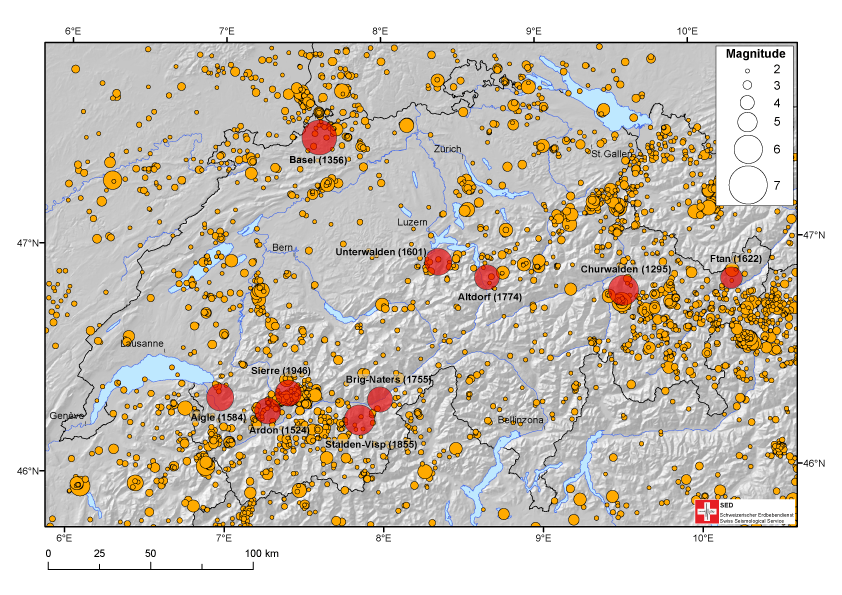24 Heures. After the tragic earthquake in Italy, some are wondering if something similar could happen in Switzerland. Speaking to the newspaper 24 Heures, geologist Raphaël Mayoraz, says “People tend to forget, but our country has already experienced earthquakes of 6 or more.” © Cristian Andriana | Dreamstime.com The Swiss Seismological Service (SED) at ETH Zurich completed ten years of earthquake research in 2015. Their new model shows that earthquakes are a serious hazard for Switzerland and the natural hazard with the greatest potential for causing damage. According to SED, the mountainous canton of Valais is the region at highest risk, followed by Basel, Graubünden, the St. Gallen Rhine Valley, and central Switzerland. Raphaël Mayoraz agrees and says two cantons are particularly at risk: Valais and Basel. In 1946 a tremor of 6.1 struck near the town of Sierre (although SED measured this quake at 5.8), killing four people. Back then there were very few people living on the Rhône plateau. Today the impact would be greater. The largest earthquake in Switzerland’s recorded history occurred in Basel in 1356 and measured 6.6. This quake and nine other notable ones since are shown in red on the SED map below. The major tremor closest to Lake Geneva occurred in Aigle in 1584 and measured 5.9. The most recent occurred in 1946 in Sierre in Valais and was registered at 5.8.
Topics:
Investec considers the following as important: Earthquake insurance Switzerland, Earthquake Switzerland, environment, Property
This could be interesting, too:
Investec writes The Swiss houses that must be demolished
Investec writes Swiss rent cuts possible following fall in reference rate
Investec writes The rise in rental scams in Switzerland
Investec writes The rapidly fading economics of solar panels in Switzerland
24 Heures.
After the tragic earthquake in Italy, some are wondering if something similar could happen in Switzerland.
Speaking to the newspaper 24 Heures, geologist Raphaël Mayoraz, says “People tend to forget, but our country has already experienced earthquakes of 6 or more.”

© Cristian Andriana | Dreamstime.com
The Swiss Seismological Service (SED) at ETH Zurich completed ten years of earthquake research in 2015. Their new model shows that earthquakes are a serious hazard for Switzerland and the natural hazard with the greatest potential for causing damage.
According to SED, the mountainous canton of Valais is the region at highest risk, followed by Basel, Graubünden, the St. Gallen Rhine Valley, and central Switzerland. Raphaël Mayoraz agrees and says two cantons are particularly at risk: Valais and Basel. In 1946 a tremor of 6.1 struck near the town of Sierre (although SED measured this quake at 5.8), killing four people. Back then there were very few people living on the Rhône plateau. Today the impact would be greater.

The largest earthquake in Switzerland’s recorded history occurred in Basel in 1356 and measured 6.6. This quake and nine other notable ones since are shown in red on the SED map below. The major tremor closest to Lake Geneva occurred in Aigle in 1584 and measured 5.9. The most recent occurred in 1946 in Sierre in Valais and was registered at 5.8.

Raphaël Mayoraz says, despite much research, predicting earthquakes with precision is not yet possible. The mechanics are still not fully understood and quake epicentres are often 10 km below the surface. We have no instruments that work at that depth. Earthquakes over 6 happen around once every 100 years. In Valais we expect another major quake between now and 2040.
Is Valais ready? We are never sufficiently ready he says, but we are trying to increase the pressure. Since 2004, building rules in Valais have required new construction to meet earthquake standards. In addition, education around what to do in the event of an earthquake has been stepped up.
Is this enough? Mr Mayoraz says they are in a good but not yet excellent position. Recent measures are only beginning to have an impact. For example Sion’s new hospital will be built to new seismic standards. In the meantime he hopes the next earthquake will wait.
More on this:
Read full 24 Heures article (in French) – Take a 5 minute French test now
